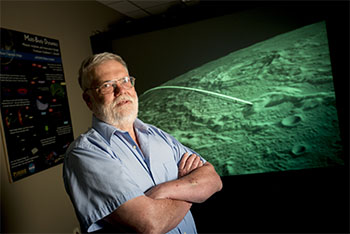The Herbert Newby McCoy Award

Jay Melosh – 2014 Herbert Newby McCoy Award
H.J. Melosh is a Distinguished Professor of Earth, Atmospheric and Planetary Sciences, Physics and Astronomy, and Aeronautical and Astronautical Engineering at Purdue University
Jay Melosh received an AB degree in physics (magna cum laude) from Princeton University in 1969 and a PhD in physics and geology from Caltech in 1973.
His principal research interests are impact cratering, planetary tectonics, and the physics of earthquakes and landslides. His recent research includes studies of the giant impact origin of the moon, the K/T impact that extinguished the dinosaurs, the ejection of rocks from their parent bodies and the origin and transfer of life between the planets
He is a science team member of NASA's Deep Impact mission that successfully cratered comet Tempel 1 on July 4, 2005, and flew by comet Hartley 2 on Nov. 9, 2010. He also is a co-investigator of the GRAIL mission that returned detailed data on the Moon's gravity field.
Professor Melosh is a Fellow of the Meteoritical Society, the Geological Society of America, the American Geophysical Union and the American Association for the Advancement of Science. He was awarded the Barringer Medal of the Meteoritical Society in 1999, the Gilbert prize of the Geological Society of America in 2001 and the Hess Medal of the American Geophysical Union in 2008.
He was a Guggenheim Fellow in 1996-97 and a Humboldt Fellow at the Bavarian Geological Institute in Bayreuth, Germany, in 2005-06. Asteroid #8216 was named “Melosh” in his honor. He was elected to the U.S. National Academy of Sciences in 2003 and the American Academy of Arts and Sciences in 2011.
He has published approximately 180 technical papers, edited two books and is the author of the text “Planetary Surface Processes” with Cambridge University Press.
Abstract of Lecture
Collisions with asteroids and comets used to be the stuff of science fiction. Starting with the Apollo missions' revelations about our Moon, however, it has gradually dawned on the scientific world that collisions between objects from microscopic to planetary dominated nearly every aspect of our planetary system's birth. Long after the birth of our planet, a rare asteroid impact initiated the extinction of the dinosaurs. As recently as Feb. 15, 2013, the atmospheric disintegration of a building-sized space rock terrified residents of the city of Chelyabinsk, Siberia. Few people in Greater Lafayette are aware that the scar from an ancient asteroid impact lies only 30 miles away, underneath the town of Kentland, Indiana. Impacts on Mars have sent us samples of that planet in the form of meteorites and just might have once transferred living organisms between our two planets. Modern computer models are now revealing just what happens when an irresistible force — a speeding asteroid — meets an immovable object such as the Earth, Mars or the Moon.
Research Accomplishments
Professor Melosh is the world authority on the subject of meteorite impact cratering. Aside from many individual papers, he published a monograph titled “Impact Cratering: A Geologic Process” in 1989 that is still recognized as the definitive exposition of the subject. Almost every modern scientific paper on impact cratering cites his book.
His advice on impact craters is widely sought by industry, government agencies and TV documentary producers (for his appearance in many documentaries on impacts, asteroids and extinctions, he is cited in the movie star database IMDb).
Melosh's work on impact craters began in 1975 with a fundamental analysis of the stability of freshly formed craters that showed that the rock around an impact crater is unusually weak. He explained this weakening by a novel mechanism he named “acoustic fluidization” that also explains the atypical mechanical behavior of very large landslides and earthquakes.
His mechanism for explaining the anomalous weakness of earthquake faults is one of the important contenders for the resolution of the still-unsolved problem of what causes the extreme weakness of mature faults like the San Andreas.
In the 1980s, he played a leading role in understanding the mechanism by which the Martian and Lunar meteorites are blasted off their parent planets. His “spallation mechanism” is currently accepted as the means by which this ejection occurs. He extended this spallation idea to propose that living organisms may survive exchange between planets, an idea that he has continued to explore in many publications and experiments with biologist colleague Wayne Nicholson.
This idea of “lithopanspermia” is now widely accepted as a paradigm among astrobiologists. One of his most highly cited papers concerns the ability of ordinary soil bacteria to survive in the space environment.
Melosh played a key role in establishing the giant impact origin of the Moon and in deducing the consequences of that impact for the early Earth and the formation of its core. More recently, he collaborated with David Rubie of the BGI in Germany to perform a definitive analysis of the equilibration of core metal and magma on the early Earth that, for the first time, explains the strange siderophile element abundances in the Earth's mantle.
In the wake of Luis and Walter Alvarez's proposal that the K/T extinction was caused by a large impact, Melosh and colleagues suggested that the global rainback of fast distal ejecta was the immediate cause of land extinctions, which were caused by thermal radiation from the infalling ejecta. These predictions were largely validated by the 1994 impact of comet Shoemaker/Levy 9 on Jupiter.
He also made the first accurate estimate of the size of S/L-9 from a tidal breakup model and demonstrated that previously enigmatic crater chains on Callisto, a moon of Jupiter, were the result of impacts by tidally dispersed comets. He has continued to contribute fundamental ideas to the study of both large and small impact craters.

